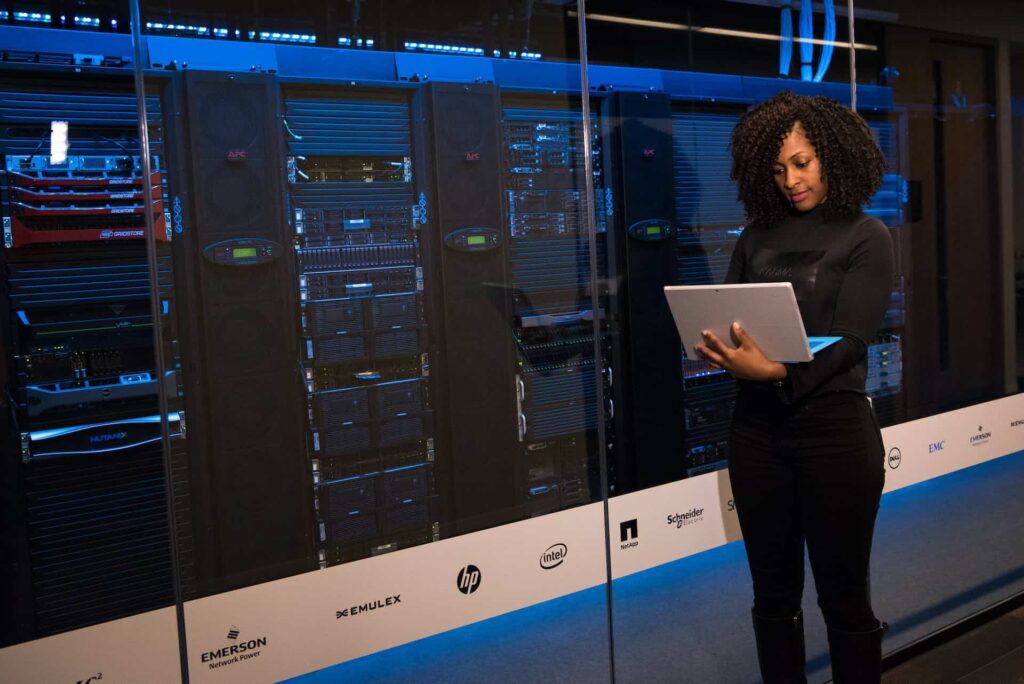Information and Communication Technology, commonly known as ICT, represents an extensive sector within our digital economy that involves the integration of telecommunications and computers. Essentially, it is an umbrella term that includes any communication device or application, encompassing radio, television, cellular phones, computer and network hardware, satellite systems, and the various services and applications associated with them such as videoconferencing and distance learning. ICT’s significance lies in its ability to enable the processing and transmission of digital information, which is fundamental to almost all aspects of modern life.
The scope of ICT spans from simple digital literacy—understanding the basics of digital devices and software applications—to the complex interconnected world of the Internet of Things (IoT), artificial intelligence (AI), and sophisticated computing. Its infrastructure is the backbone of digital economies, facilitating e-commerce, e-governance, digital education, and remote work. As ICT continuously evolves, it reshapes how we communicate, learn, and conduct business, demanding new skills and creating new challenges that society must address.
Key Takeaways
- ICT integrates telecommunications and computers to process and transmit digital information.
- The infrastructure of ICT is crucial for e-commerce, digital education, and governance.
- Ongoing evolution in ICT creates new societal opportunities and challenges.
Understanding ICT
Information and Communication Technologies (ICT) encompasses a broad spectrum of tools and systems that facilitate global connectivity and information management. The field merges computer technology with telecommunication infrastructure, enabling users to access, transmit, and manipulate information swiftly.
Definition and Components
ICT refers to a diverse set of technological tools and resources used to communicate, create, disseminate, store, and manage information. This encompasses computers, the internet, broadcasting technologies (radio and television), and telephony. The key components of ICT can be broken down into hardware (the physical components of devices and networks), software (programs and applications that run on hardware), and telecommunications (the transmission and reception of data and information across distances).
History and Evolution
The history of ICT is a tale of gradual advancement, from early tools like the radio and telephone to advanced digital systems that define the modern world. The evolution of telecommunications and computing technologies has transitioned humanity from analog to digital experiences, marked by milestones such as the advent of personal computers, the explosion of the internet, and the proliferation of mobile devices. These innovations have been instrumental in creating an interlinked global community.
Types of ICT
Different types of ICTs have unique functions within the digital ecosystem:
- Broadcasting Technologies: Radio and television for disseminating information to a wide audience.
- Telephony: Mobile and fixed-line services facilitate voice, text, and video communications.
- Computing Devices: Computers, laptops, tablets, and other devices for diverse personal and professional tasks.
- Networks: Both wired and wireless networks, including the internet, local area networks (LANs), and cellular networks.
- Satellites: For telecommunications and broadcasting signals over vast distances.
Each category plays a crucial role in enabling comprehensive and accessible communication technologies for modern society.
ICT Infrastructure
ICT infrastructure forms the physical and virtual backbone of modern communication and data management. It is an intricate system that supports the flow of information through technology.
Networking Basics
The foundation of ICT infrastructure is networking, a key component that connects different devices and systems. Networks enable the sharing of resources and information across different locations. Networking basics include understanding the structure of the internet and web, which are vast networks of interconnected devices. Local Area Networks (LAN) and Wide Area Networks (WAN) are crucial, allowing for efficient signal distribution and data exchange. Networking also involves middleware, which connects disparate systems and ensures that different components can communicate effectively.
Hardware and Software Components
Hardware and software components are essential to building a functional ICT infrastructure. Hardware includes physical devices like computers, storage devices, mobile phones, and the networking cabling necessary for connectivity. Software, on the other hand, encapsulates the programs and operating systems that run on the hardware, which provide the platform for tasks such as data processing, management, and communication.
Telecommunication Systems
In ICT, telecommunication systems refer to the technologies that facilitate electronic communication at a distance, encompassing telephony networks, cell phones, smartphones, and other telecommunication devices. These systems heavily rely on complex telecommunications protocols to transmit voice, data, and video across the globe. They include fixed-line and wireless connections that form a crucial part of the ICT infrastructure, allowing instant access to the internet and a range of communication services.
Applications of ICT
Information and Communication Technology (ICT) encompasses different tools and systems that facilitate the management and dissemination of information in various sectors including business, education, healthcare, and governance. These applications enhance efficiency and knowledge-sharing across a wide spectrum of activities.
In Business
Applications: ICT technology serves as the backbone for e-commerce platforms, improving the purchasing process and expanding global market access. In the realm of business management, sophisticated software tools streamline operations ranging from inventory control to customer relationship management.
- Management Systems: Implementation of Enterprise Resource Planning (ERP) systems for better data analysis and decision-making.
- Technology Tools: Utilization of Customer Relationship Management (CRM) systems to optimize marketing and sales strategies.
In Education
Education and Knowledge: ICT has revolutionized learning by providing digital tools that support distance education and foster collaborative learning environments. The incorporation of ICT in education enhances the reach and accessibility of educational resources, allowing for an uninterrupted learning experience through:
- E-learning Platforms: Offering courses via Massive Open Online Courses (MOOCs) and virtual classrooms.
- Knowledge Repositories: Creation of digital libraries and databases that provide students and educators with a wealth of information.
In Healthcare
Health and Telemedicine: In the health sector, ICT applications are critical for delivering services efficiently. They support the management of patient information and enable telemedicine, facilitating remote diagnosis and treatment which is crucial in enhancing the quality of care.
- Data Management: Secure electronic health records improve the storage and sharing of patient information.
- Telemedicine Services: Video conferencing tools and remote monitoring systems allow healthcare providers to offer services to patients at a distance.
In Governance
E-Governance and Service: ICT transforms how citizens interact with the government. It aids in creating transparent, efficient, and accessible e-governance systems that enhance the delivery of public services.
- Public Service Portals: Online platforms for service delivery streamline processes such as filing taxes and applying for permits.
- Management Tools: Integrated information systems used by government agencies improve data handling and inter-departmental communication.
ICT and Society
Information and Communication Technologies (ICT) have become the backbone of social interaction and have redefined the way individuals connect with each other and the world. From education to social development, ICT shapes the contours of modern societies.
Social Impact
In the digital world, ICT is a double-edged sword; it not only fosters social development by connecting people globally but also creates a digital divide. Those with access to the latest gadgets—smartphones, emails, websites, and various audio and video players—experience a heightened sense of inclusion. Conversely, segments of society lacking access to these technologies may face increased isolation. ICT also introduces convenience into daily routines, revolutionizing everything from entertainment to more serious affairs of governance and healthcare.
ICT in Daily Life
The average person’s daily life is deeply infused with ICT. From smartphones that wake us up to emails checked over breakfast, technology is a constant companion. Gadgets such as GPS systems, smart watches, and audio players enhance daily activities, making information-gathering and communication seamless. ICT acts as a bridge that converts mundane tasks into efficient and enjoyable experiences, shifting the interaction with almost every service and entertainment form into the digital realm.
Digital Literacy and Skills
The rise of ICT necessitates a digital literacy and skills framework recognized across various industries. The Skills Framework for the Information Age (SFIA) provides a common reference model catering to professionals in ICT roles. Education systems around the world are increasingly prioritizing ICT education to prepare students for the demands of a digitalized economy. This preparation enables individuals to contribute meaningfully to society, equipping them with the knowledge to navigate and succeed in a digital ecosystem.
Emerging Trends in ICT
The landscape of Information and Communication Technology (ICT) continuously evolves, pushing the boundaries of innovation. Key developments such as Artificial Intelligence (AI) and Robotics, the Internet of Things (IoT), and Cloud Computing redefine the way data is processed, stored, and communicated.
Artificial Intelligence and Robotics
AI continues to make significant strides in various industries, allowing for smarter automation and analytical capabilities. Robotics, integrated with AI, propels the ability of machines to perform complex tasks with precision. Autonomous vehicles and advanced manufacturing robots are direct outcomes of this synergy, demonstrating improved efficiency and decision-making processes.
Internet of Things (IoT)
IoT stands out by transforming ordinary devices into interconnected, smart tools that enhance data communication and facilitate real-time analytics. This network of devices grows exponentially, ranging from household appliances to industrial sensors, all contributing massive amounts of data that fuel further innovations in ICT.
Cloud Computing
Cloud Computing has become the backbone for data storage and services, enabling ubiquitous access to resources and information. It supports a wide array of functionalities, from webcasting to collaborative projects, ensuring flexibility and scalability without the need for extensive infrastructure. This technology also underpins advancements in AI by providing the necessary computational power and data management systems.
Challenges and Solutions
Information and Communication Technologies (ICTs) are central to modern society, bringing numerous benefits but also presenting significant challenges. Addressing these challenges requires comprehensive solutions that uphold security, maintain privacy, address ethical considerations, and mitigate environmental impacts, specifically climate change. Efforts to achieve a circular economy also intersect with the sustainable management of ICT.
Security Concerns
Security within ICT is paramount, as these technologies are integral to maintaining the integrity of data and networks. Attacks on ICT infrastructure can destabilize societal functions and compromise sensitive information. One solution to these security concerns involves implementing robust encryption standards and multi-factor authentication to protect data across networks.
Privacy and Ethical Issues
Privacy concerns arise when there is a risk of unauthorized data collection or exposure. The ethical use of ICT also demands stringent data protection protocols to guard against invasive surveillance and protect personal information. Regulatory frameworks such as GDPR have set precedents for privacy protection, requiring consent for data collection and ensuring users’ rights to access and control their personal data.
Environmental Impact
The production, usage, and disposal of ICT-related hardware pose significant challenges to the environment, notably contributing to climate change. ICT stakeholders are increasingly adopting circular economy principles, which emphasize the reuse and recycling of electronic components to minimize waste. Energy-efficient data centers and greener production methods are examples of efforts to reduce the climate change footprint of these technologies.
Global ICT Policies and Standards
Global ICT policies and standards are critical in shaping how information and communication technologies are developed, implemented, and governed worldwide. These frameworks and protocols ensure interoperability, security, and efficiency across international borders.
Regulatory Frameworks
Regulatory frameworks in ICT are established to create a cohesive environment for the global digital economy. They involve policies and legislation aimed at ensuring equitable access to information and technology. Organizations like the United Nations Educational, Scientific and Cultural Organization (UNESCO) participate in shaping these frameworks by facilitating international collaboration. The World Summit on the Information Society (WSIS), a two-phase United Nations summit, plays a crucial role in these efforts by setting targets and action lines for the achievement of a global information society.
Standards and Protocols
Standards and protocols are the technical underpinnings of global ICT. They define the technical criteria and methodologies for various technologies to operate seamlessly and securely across different platforms and nations. The development of these standards often involves a consensus-driven process with inputs from multiple stakeholders. Standard-setting entities, both governmental and non-governmental, focus on the creation of these open standards to foster global connectivity, enhance functionality, and promote innovation in the ICT sector. Protocols, as part of these standards, constitute the specific procedures and rules that govern the exchange and transmission of data in a networked system, ensuring that systems and devices can communicate effectively.
The Future of ICT
The future of ICT is shaped by its capacity to converge disparate technologies and foster sustainable development, addressing global challenges like climate change and promoting a circular economy.
Technological Convergence
In the arena of ICT, future progression pivots around technological convergence, where telecommunications, information technology, and media meld into a seamless ecosystem. This integration is hinged on unified communications, a concept where various communication tools and applications are linked together, allowing users to communicate more efficiently. For instance, smart buildings and smart roads will be more commonplace as edge computing advances, harnessing the power of real-time insights to automate and optimize functions.
ICT for Sustainable Development
ICT plays a pivotal role in driving sustainable development goals. It aids in the monitoring and managing of environmental resources, thereby contributing to the mitigation of climate change impacts. The sector also embraces the principles of the circular economy, which prioritizes the reuse and recycling of electronic components to minimize waste. Furthermore, the development of green technologies in ICT ensures that emerging and established telecommunication systems contribute positively to sustainable development efforts, continuing to innovate while reducing the ecological footprint.
Case Studies and Real-World Examples
Information and Communication Technology (ICT) has far-reaching impacts across various sectors. Case studies have shown that ICT integration in education enhances the learning process by connecting theoretical knowledge to real-life situations. For example, students engaging with real-world IT case studies develop a deeper understanding of complex, real-world problems as opposed to textbook exercises.
In the business realm, ICT tools have transformed operations, enabling companies to innovate and improve efficiency. Project management and customer relationship management systems are typical examples where technology creates a competitive edge.
The health sector has seen ICT used as a powerful tool in managing patient records and telemedicine, significantly optimizing patient care. With the advent of electronic health records, medical professionals can deliver prompt and more informed care to patients.
Entertainment has been revolutionized by ICT, with streaming services and digital media providing instant access to content. The disruption in traditional media showcases the profound impact of ICT on how content is consumed.
Table 1: Impact of ICT in Key Sectors
| Sector | Impact of ICT |
|---|---|
| Education | Connects learning to real-life situations, enhances engagement |
| Business | Streamlines operations, fosters innovation |
| Health | Improves patient care, optimizes record management |
| Entertainment | Changes content delivery and consumption patterns |
These examples underscore the real-world applications of ICT and how it spans across different areas of society, underlining ICT’s central role in driving change and advancing development.
Frequently Asked Questions
This section aims to address some of the most common inquiries regarding Information and Communication Technology, providing concise and clear answers to deepen the understanding of ICT systems, their impact, advantages, examples, tools, and evolution.
What are the key components of an ICT system?
The core components of an ICT system include hardware like computers and networking equipment, software such as applications and operating systems, and telecommunications technologies for data transmission.
How does ICT influence daily life?
ICT influences daily life by facilitating instant communication, providing access to vast amounts of information, and allowing for more efficient management of personal and professional activities, exemplifying how ICT is embedded in everyday interactions.
What are the primary advantages of using ICT?
The primary benefits of using ICT include improved communication, enhanced learning opportunities, increased productivity in work environments, and expanded access to a global marketplace.
Can you list examples of ICT devices used in everyday settings?
Some common ICT devices used in everyday settings are smartphones, laptops, tablets, and smart home devices, which are part of the broader ICT infrastructure.
What are the various tools associated with ICT and their functions?
Various tools associated with ICT include search engines for accessing information, content management systems for organizing data, and communication platforms like email and social media, all serving distinct functions in the information and communication technology landscape.
How has ICT evolved to shape modern communication and information exchange?
ICT has evolved through the advent of the internet and mobile technology, revolutionizing the means of communication and information exchange to enable a more connected and informed global society.



